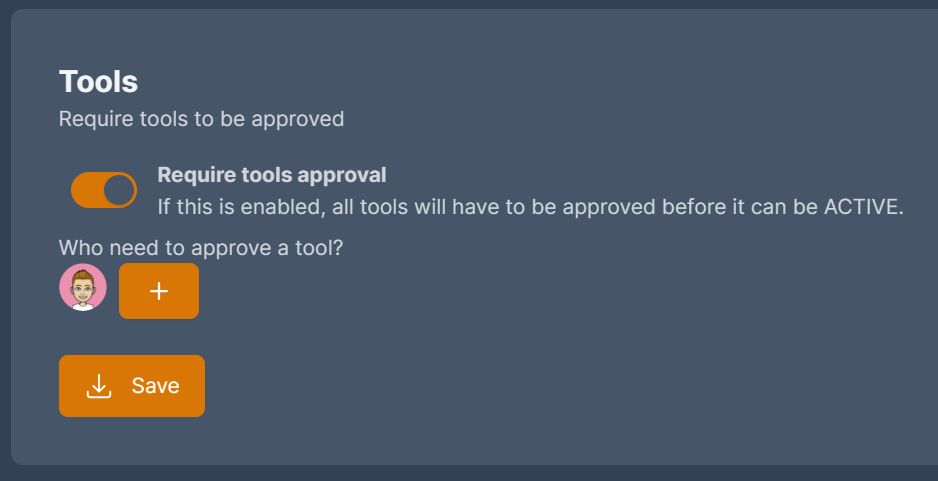
HowTo: Tool approval
← Back to BlogWith so many tools out there, the possibilities are endless. As AI-powered tools grow rapidly, so do concerns about privacy. With government regulations like GDPR, it's important to make sure you know where your data is. By making sure your colleagues/employees aren't using random tools and putting your hard-earned customer data into them, you can set up a tool approval flow.
More tools
The technology market has evolved at an astonishing pace, resulting in a plethora of tools designed to simplify tasks, increase efficiency, and foster innovation. From project management software to AI-powered content generators, the options are vast and varied. These tools have the potential to revolutionize the way we work, communicate, and collaborate. But with great power comes great responsibility.
Privacy
As we generate and share more data through these tools, our privacy concerns grow. We've seen numerous high-profile data breaches, leaks, and privacy violations over the years, highlighting the urgent need for stronger data protection measures. This is where regulations such as the European Union's General Data Protection Regulation (GDPR) come into play.
GDPR
GDPR serves as a benchmark for data protection around the world. It requires organizations to be transparent about how they handle data, obtain explicit consent for data processing, and provide individuals with the right to access, rectify, or delete their data. While GDPR is a European regulation, it has far-reaching implications for businesses and individuals worldwide, as many companies choose to adhere to these standards to ensure data privacy.
What do we need to know?
To figure out why you need a tool, ask yourself a few questions. You should focus on a few areas: Legal (which is mostly GDPR related), Security (will the information be secure), and Financial (what will it cost, how will it add value to my business). Let's look at some of those areas:
1. What do you need the tool for?
This is the most basic question you should ask yourself. What problem does this tool solve? Everything you use is always meant to solve a problem. Whether that problem is giving you more time to do other things, or it is a real problem like how do I share passwords between employees.
2. What information will the tool get?
Every tool has some kind of data. If you know what data you're putting in, you can get an overview of your data. And let's face it, the only reason we need to do this is because of GDPR.
3. Where do they store data?
Some countries require you to store data in a specific region or country. So knowing what data you are putting into the tool and where it is located is very important. Where the data is stored means what laws apply to it. If you store data in the United States, U.S. authorities may request the data.
4. How do they handle your data?
Not only is the physical location of the data important, but so is the security of the data. The main question we try to answer is: is your data encrypted? In other words, can other people read the data? You could also check if your data is being sold. You probably work hard for your customers and their data, you don't want other people to make money from it.
5. How much does it cost?
Making sure you don't spend too much money is an obvious question to ask about a tool. But at the same time: You have to spend money to make money. At the end of the day, you decide what the tool is worth.
Where does ToolHive come in?
With ToolHive, you can make this process easier. By enabling the tool approval process. Follow the steps below:
Step 1: Go to your organisation settings. Enable the "Require tools approval" setting.

Step 2: Next, select who needs to approve a tool. Anyone can approve a tool, but only the required people need to approve.
Step 3: Create a new tool. It will be created in "DRAFT" status. Fill in the tool information.
Step 4: Next, change the status of the tool to "REQUESTED". This tells the people who need to approve the tool that the tool is now ready for review.
Step 5: Next, wait for your colleagues to approve the tool. On the tool page, each person will see a bar with an Approve/Reject button. Read all the information on the tool page and then choose what you want to approve or reject the tool.
Step 6: When all required people have chosen to approve the tool, the status will automatically change to "ACTIVE". You will receive a notification of this change.
Step 7: When all required people have chosen to deny the tool, the status will automatically change to "DENIED". You will receive a notification of this change.
Step 8: Based on this new status, you can now either use the tool or find a way to fix the reasons it was rejected.
There you go. An easy way to provide an approval flow for tools in your organization. This way you don't end up using more tools than you need, saving you money and possibly GDPR violations.